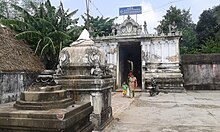Thiruchsemponsey
| Perarulaalan Perumal Temple | |
|---|---|
 | |
| Religion | |
| Affiliation | Hinduism |
| District | Mayiladuthurai |
| Deity | Perarulaalan Perumal (Vishnu) Alli Mamalar (Lakshmi) |
| Festivals | iypasi swati bromotsavam |
| Features |
|
| Location | |
| Location | Thirunangur |
| State | Tamil Nadu |
| Country | India |
| Geographic coordinates | 11°10′42″N 79°46′46″E / 11.17833°N 79.77944°E |
| Architecture | |
| Type | Dravidian architecture |
| Direction of façade | East facing standing posture |
Thiruchsemponsey or Perarulaalan Perumal Temple is dedicated to Hindu god
It is one among the eleven divyadesams of
, to Thirunangur.Legend
The legend of all the eleven temples of Thirunangur are closely associated with each other. As per legend, the Hindu god
Architecture
Thiruchsemponsey has a small temple complex. It is located in Thirunangur, a small village, 10 km away from
Religious significance
The temple is revered in
Worship practices and festivals

The temple is open from 8 a.m. to 10 a.m. and 5 p.m. to 7 p.m. The temple priests perform the pooja (rituals) during festivals and on a daily basis. As at other Vishnu temples of Tamil Nadu, the priests belong to the Pancharathra aagama Vaishnavaite community, a Brahmin sub-caste. The temple rituals are performed four times a day: Ushathkalam at 8 a.m., Kalasanthi at 10:00 a.m., Sayarakshai at 5:00 p.m. and Ardha Jamam at 7:00 p.m. Each ritual has three steps: alangaram (decoration), neivethanam (food offering) and deepa aradanai (waving of lamps) for both Perarulaalan and his consort Allimaamalaral Nachiyar. During the worship, religious instructions in the Vedas (sacred text) are recited by priests, and worshippers prostrate themselves in front of the temple mast. There are weekly, monthly and fortnightly rituals performed in the temple. The hereditary honors are received by the descendants of Sri Gomadam Azhagiyasingar family.[6]
During the new moon day of the Tamil month Thai, the
References
- ^ R. 2001, pp. 470-1
- ^ ISBN 9788120601512.
- ^ a b "திருநாங்கூர் நாராயண பெருமாள் கோவில்" (in Tamil). 21 October 2019. Retrieved 17 July 2021.
- ^ R. 2001, pp. 498-9
- ^ ISBN 978-81-88661-42-8.
- ^ a b "Sri Perarulalan temple". Dinamalar. 2014. Retrieved 31 May 2014.
- ^ "அருட்சேவை அருளும் திருநாங்கூர் கருடசேவை" (in Tamil). Daily Thanthi. 25 January 2020. Retrieved 17 July 2021.
- ^ a b S., Prabhu (12 July 2012). "Shrine dedicated to Arjuna". The Hindu. Retrieved 9 September 2013.
- ^ "Garuda Sevai" (PDF). Ramanuja.org. Retrieved 19 August 2011.
External links
- R., Dr. Vijayalakshmy (2001). An introduction to religion and Philosophy - Tévarám and Tivviyappirapantam (1st ed.). Chennai: International Institute of Tamil Studies.

